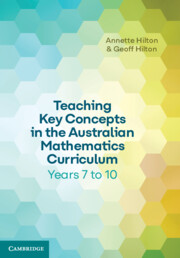Book contents
- Teaching Key Concepts in the Australian Mathematics Curriculum Years 7 to 10
- Acknowledgement of Country
- Teaching Key Concepts in the Australian Mathematics Curriculum Years 7 to 10
- Copyright page
- Contents
- About the authors
- Preface
- Acknowledgements
- Chapter 1 Mathematics teaching and learning in lower secondary schooling (Years 7 to 10)
- Chapter 2 The principles of mathematics education
- Chapter 3 The Australian Curriculum: Mathematics
- Chapter 4 Number
- Chapter 5 Algebra
- Chapter 6 Measurement
- Chapter 7 Space
- Chapter 8 Statistics
- Chapter 9 Probability
- Chapter 10 Authentic tasks in mathematics
- Index
- References
Chapter 10 - Authentic tasks in mathematics
Published online by Cambridge University Press: 13 August 2025
- Teaching Key Concepts in the Australian Mathematics Curriculum Years 7 to 10
- Acknowledgement of Country
- Teaching Key Concepts in the Australian Mathematics Curriculum Years 7 to 10
- Copyright page
- Contents
- About the authors
- Preface
- Acknowledgements
- Chapter 1 Mathematics teaching and learning in lower secondary schooling (Years 7 to 10)
- Chapter 2 The principles of mathematics education
- Chapter 3 The Australian Curriculum: Mathematics
- Chapter 4 Number
- Chapter 5 Algebra
- Chapter 6 Measurement
- Chapter 7 Space
- Chapter 8 Statistics
- Chapter 9 Probability
- Chapter 10 Authentic tasks in mathematics
- Index
- References
Summary
In order to be effective mathematics educators, teachers need more than content knowledge: they need to be able to make mathematics comprehensible and accessible to their students. Teaching Key Concepts in the Australian Mathematics Curriculum Years 7 to 10 ensures that pre-service and practising teachers in Australia have the tools and resources required to teach lower secondary mathematics.
By simplifying the underlying concepts of mathematics, this book equips teachers to design and deliver mathematics lessons at the lower secondary level. The text provides a variety of practical activities and teaching ideas that translate the latest version of the Australian Curriculum into classroom practice. It covers the challenges of middle year mathematics, including the current decline in student numeracy, as well as complex theories which teachers can struggle to explain clearly. Topics include number, algebra, measurement, space, statistics and probability. Whether educators have recently studied more complicated mathematics or are teaching out of field, they are supported to recall ideas and concepts that they may have forgotten – or that may not have been made explicit in their own education.
Authored by experienced classroom educators and academics, this book is a vital resource for pre-service and practising Years 7 to 10 mathematics teachers, regardless of their backgrounds and experiences.
Information
- Type
- Chapter
- Information
- Publisher: Cambridge University PressPrint publication year: 2025
References
Accessibility standard: WCAG 2.0 A
Content Navigation
Allows you to navigate directly to chapters, sections, or non‐text items through a linked table of contents, reducing the need for extensive scrolling.
Provides an interactive index, letting you go straight to where a term or subject appears in the text without manual searching.
Reading Order & Textual Equivalents
You will encounter all content (including footnotes, captions, etc.) in a clear, sequential flow, making it easier to follow with assistive tools like screen readers.
You get concise descriptions (for images, charts, or media clips), ensuring you do not miss crucial information when visual or audio elements are not accessible.
You get more than just short alt text: you have comprehensive text equivalents, transcripts, captions, or audio descriptions for substantial non‐text content, which is especially helpful for complex visuals or multimedia.
Structural and Technical Features
You gain clarity from ARIA (Accessible Rich Internet Applications) roles and attributes, as they help assistive technologies interpret how each part of the content functions.
